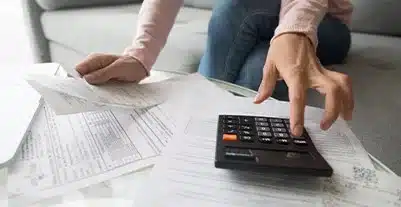Investing in a mortgage is a big deal, so it’s crucial to know all of the details of your loan. Generally, when you make payments on a personal or business loan, your payments will be split into two categories; the principal amount and loan interest. Consider the principal to be the amount you borrow and must repay. While interest is the amount of money you’ll have to pay if you borrow it. So, if you or your company takes out a loan from a bank, you have a loan with an initial principal, which is the size of your loan. Regardless, as you make payments on the loan, some of your payments will go toward the principal, while others will go toward paying down the accrued interest. This comprehensive guide has all the information you need to learn more about the principal amount of a loan and how to find it.
What Is the Principal Amount?
Generally, when it comes to financial terms, the term “principal” can have a variety of meanings for different people. However, the amount borrowed or invested at the outset is the most commonly cited example. While it has another meaning in regards to a bond’s face value or when parties discussing a business transaction.
Nevertheless, the principal amount is the amount of money you owe before calculating interest. Or the amount of money invested before realizing a profit. For every designated period of time that the principal remains unpaid, the loan will accrue interest and other fees. This is true for all loans. The same is true for investments, but rather than accruing additional debt, the investor receives an increase in the principal amount they invest.
On the other hand, a principal payment is a contribution to the outstanding balance of a loan. Principal payments are payments you make on loans that reduce the remaining balance of the loan, rather than interest payments themselves. So, when you make a payment that reduces the amount you owe on a loan, you can simply say you make a “principal payment.”
Principal Amount of a Loan
It doesn’t matter what type of loan the borrower takes out, the initial amount is known as the principal. Generally, lenders charge interest in addition to the principal amount you owe them when you take out a loan. In most cases, interest is calculated as a percentage (%) of the loan’s principal. However, to find out or see how much of each payment goes toward the principal amount and how much toward interest, you’ll need to look at either your loan amortization schedule or your monthly loan statement. Amortization is the term used to describe the process by which a loan’s principal and any accumulated interest are reduced over time.
On the other hand, if you have a mortgage, your payments are automatically set up to pay off the interest first and then the principal. Basically, a borrower in this situation will pay less interest over time, but he/she will pay more toward the principal.
The principal refers to the amount you invest, as well as the amount invested which will accrue interest. Meanwhile, it’s worth noting that the investor’s yields, or interest, are what this is all about. In other words, the investor’s returns can be compounded by reinvesting the interest earned in the previous period to earn more.
How the Principal Amount of Loan Work
Let’s take a look at this simple case. In order to purchase $15,000 worth of business equipment, you must take out a loan. Assuming a $5,000 down payment at the time of loan application, the initial loan balance will be $10,000. The annual interest rate for the bank is 4%.
Even though your principal will not change (it still stands at $10k). Regardless, you’ll have an interest balance of $33 ($10,000 x (4%/12)) next month. So, let’s say you decide to make a monthly payment of $500. The interest portion of that payment is $33, while the remaining $473 stand to reduce the principal. Your loan balance now stands at $9,527 after you made the payment.
Usually, the bank amortizes the loan in order to calculate the monthly payments. Thereby, you’re able to see in advance exactly how the loan will affect your finances. And also the length of time it will take to pay off the principal as well as how much of your monthly payments will go to principal and interest.
On the other hand, it is more likely that your monthly payments will go toward reducing interest than toward decreasing the principal when you are amortizing a large loan.
Generally, when your principal is large, definitely, you’ll owe more interest. However, with every payment you make, you’re reducing the amount of interest you pay and increasing the amount of money that goes directly toward reducing the principal. Regardless, it will be clear on your statement each month how your monthly payment is split up.
How to Find the Principal Amount
Using an instance where we have the principal loan amount and used it to calculate the interest rate. So, assuming we already have the interest rate, the amount of interest, as well as the duration of the loan in hand. But we now need to find out and determine only the loan’s principal amount?
Basically, the Interest formula I = PRT is not the same as the principal formula. However, when rearranged, you can employ it to figure out or find out the principal amount. As a result, the new formula would be P = I / (RT)
Let’s see how this works by calculating the principal amount of a $20,500 loan with an annual interest rate of 6.5 percent for 12 years.
To find the answer, we use the equation P = I / (RT). To sum it up:
P= $20500/ (0.06.5 X12) =26,282
The loan’s principal amount is $26,282.
What Is the Procedure for Recouping the Principal?
Most of the minimum monthly payment you make on a large loan will go toward interest, followed by a portion that goes toward the principal. This however is due to the fact that interest accrues at a higher rate with a higher principal. As such, interest is paid first.
Basically, the amount of each portion of your monthly payment will change over time. While your monthly payments will remain the same if you pay at least your minimums. However, paying more in principal and less in interest as your payments continue means that the lower your principal is, the less interest grows.
On the contrary, it might be possible to pay only the principal of a loan. But, that’s only if your lender allows it. While on top of your minimum monthly payment, you may also have to make additional payments. Likewise, regular monthly payments can be set up with an additional payment designated solely for the principal.
Meanwhile, if you decide to make an extra payment that will apply just to the principal, you may need to notify your lender ahead of time. On the other hand, it will be such a good idea to double-check with your lender first. You should do this before sending in an extra payment to see if they accept principal only.
Typically, paying all of your interest first may be possible in some cases. However, it’s possible that this isn’t the best course of action. Nevertheless, since you would not be paying down the principal, your interest rate would not change.
What Is the Best Way to Pay off a Loan Faster?
If you’re getting teary wondering about how much interest you have to pay, you should pay attention to this encouraging update. Currently, most lenders will allow you to make extra principal payments. This however will make you pay off your loan faster. Besides, making additional principal payments will help you save money in the long run. This is because interest calculation is based on the amount of money you owe.
Nevertheless, it’s always a good idea to check with your lender, credit card company, or loan servicer to see how they handle early repayments. Some lenders automatically apply any additional payments to interest, rather than to the principal, before applying them to the debt. So, before making any additional payments, speak with your lender. This is to see if there are any penalties for paying off the loan early.
What Is a Mortgage Principal Amount?
Generally, when you take out a mortgage, the amount you borrow is known as the “principal.” Your mortgage balance is the amount you receive from the lender. That is if for instance, your lender gives you $350,000, your principal amount is $350,000. And for a fixed period of time, perhaps 30 or 15 years, you’ll make monthly payments to repay this debt.
In another word, it is the remaining sum you have to pay on a loan. Typically, you’re building equity in your home while you pay down this debt. The problem is that even fixed-rate mortgages send more money toward interest than toward the principal at the beginning of the transaction. As a result, many borrowers prefer to make “prepayments,” or extra monthly payments toward the main balance. This is to pay off their loans faster, build equity in their homes, and save money on interest. Normally, making an additional monthly payment each year can reduce the length of the loan by five years.
Meanwhile, if you want to get the most out of your loan, it helps to know exactly how your money is being distributed. The structure of your monthly payments will have a significant impact on the total cost of your mortgage and the time it takes you to own your property.
Mortgage Principal Payment & Mortgage Interest Payment
Basically, your monthly mortgage payment is made up of a variety of components, not just the principal on your loan. In addition, the lender will charge you interest for allowing you to borrow money.
The interest rate is usually calculated in percentages. Perhaps you have a $300,000 principal and an interest rate of 5% annual percentage yield (APY).
Each month, you’ll make a payment toward your principal and interest. You won’t have to worry about remembering to make two payments because your lender will combine the principal and interest into a single monthly payment.
Conclusion
Generally, lenders charge interest in addition to the principal amount you owe them when you take out a loan. In most cases, interest is calculated as a percentage of the loan’s principal. However, to find out or see how much of each payment goes toward the principal amount and how much toward interest you’ll need to look at either your loan amortization schedule or your monthly loan statement.
Principal Amount FAQs
Is a Loan Payment an Expense?
Loan payments frequently include both interest and principal reduction payments. You can call interest portion expense, while the principal portion is a reduction of liability such as Loan Payable or Notes Payable.
Is Loan Repayment Included in an Income Statement?
Only the interest component of a loan payment will display as an Interest Expense on your income statement. Your loan’s main payment will not be included in your profit and loss statement.
What happens after you pay off the principal on a mortgage?
As you pay down your main or the amount you borrowed initially, you owe less in interest. A substantially larger portion of your payment goes toward the principal at the end of your loan.
In loan, is it principle or principal amount?
It’s important to remember that in a loan, the principal is the larger amount of money, while interest is the smaller. The word “principle” is a noun that refers to a body of law or a set of rules.
Related Articles
- PRINCIPAL PLACE OF BUSINESS LLC: Definition & Examples
- Why Do I Owe State Taxes: 5 Reasons You May Owe State Taxes & How To Pay It
- Payoff Mortgage Calculator: All you need for more efficient calculations
- COMMITMENT LETTER: Definition & Overview
- WHAT IS VALUE CHAIN ANALYSIS? Definition, Importance, and Examples






